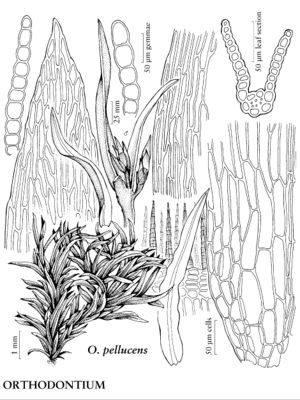Orthodontium pellucens
in J. K. A. Müller, Syn. Musc. Frond. 1: 240. 1848.
Plants 0.5–1 cm, shiny-opaque. Stems with central strand weak or absent. Leaves twisted once along leaf length when dry or moist, broadly linear, 2.5–5 mm, 0.5 mm wide mid leaf, widest mid leaf; margins plane; costa stereid cells present. Sexual condition autoicous; antheridia in many stalked buds along stem to well below perichaetium. Seta 0.7–1.4 cm. Capsule ovoid-pyriform (wider at or just beyond mid capsule), 1.5–1.7 mm, neck short; operculum long-rostrate; exostome teeth not much wider at base, finely papillose; endostome basal membrane low, segments same length as exostome teeth.
Phenology: Capsules mature winter–early spring.
Habitat: Eastern part of flora area in peaty crevices of rock, treeless heath balds of dense evergreen shrubs, mountain summits, shaded rotten wood, bark at base of trees, pine logs and stumps, peaty humus, soil, thin soil over calcareous rock, western part of flora area in moist creek ravines and canyons in moist forests
Elevation: low to moderate elevations
Distribution

Calif., N.C., Oreg., Tenn., sw Mexico, West Indies, Central America, South America, Pacific Islands (Galapagos Islands, Hawaii).
Discussion
The cells of the central cylinder of Orthodontium pellucens generally appear smaller than the epidermal cells, and a central cluster of 3 or 4 significantly smaller cells may also be demonstrated. In contrast, cells of the central cylinder of O. gracile appear larger than the epidermal cells, and no central strand is evident.
Orthodontium pellucens has perhaps the widest leaves in the genus. The medial part of the leaf reaches 0.5 mm (W. Meijer 1951), while those of O. gracile only reach 0.2 mm wide. The distal leaf in O. pellucens is more broadly acute and not flexuose-sinuate as in O. gracile. The length of the rostrum is usually 0.75–0.8 mm, that is, to 1/3 the length of the capsule (Meijer). Capsules are not known from the mountainous southeastern United States, from which only three specimens were reported by H. A. Crum and L. E. Anderson (1981). According to A. L. Andrews (1932), plants of this species in California often fruit.
Selected References
None.
